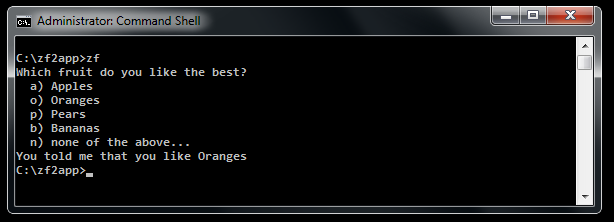Reference
Console Prompts
In addition to the console abstraction layer, zend-console provides numerous
convenience classes for interacting with the user in a console environment. This
chapter describes available Zend\Console\Prompt classes and their usage.
All prompts can be instantiated directly, and expose a show() method.
use Zend\Console\Prompt;
$confirm = new Prompt\Confirm('Are you sure you want to continue?');
$result = $confirm->show();
if ($result) {
// the user chose to continue
}
You can also use prompts statically, via the static prompt() method:
use Zend\Console\Prompt;
$result = Prompt\Confirm::prompt('Are you sure you want to continue?');
if ($result) {
// the user chose to continue
}
Both of above examples will display something like this:

Confirm
This prompt is best used for yes / no prompts.
Confirm(string $text, string $yesChar = 'y', string $noChar = 'n') : bool
| Argument | Description |
|---|---|
$text |
(string) The text to show with the prompt. |
$yesChar |
(string) The character that corresponds with the YES choice. (default is y) |
$noChar |
(string) The character that corresponds with the NO choice. (default is n) |
Example usage:
use Zend\Console\Prompt\Confirm;
if ( Confirm::prompt('Is this the correct answer? [y/n]', 'y', 'n')) {
$console->write("You chose YES");
} else {
$console->write("You chose NO");
}

Line
This prompt asks for a line of text input.
Line(
string $text = 'Please enter value',
bool $allowEmpty = false,
bool $maxLength = 2048
) : string
| Argument | Description |
|---|---|
$text |
(string) The text to show with the prompt. |
$allowEmpty |
(boolean) Can this prompt be skipped, by pressing [ENTER]? (default is false) |
$maxLength |
(integer) Maximum length of the input. Anything above this limit will be truncated. |
Example usage:
use Zend\Console\Prompt\Line;
$name = Line::prompt(
'What is your name?',
false,
100
);
$console->write("Good day to you $name!");

Char
This prompt reads a single keystroke, and optionally validates it against a list of allowed characters.
Char(
string $text = 'Please hit a key',
string $allowedChars = 'abc',
bool $ignoreCase = true,
bool $allowEmpty = false,
bool $echo = true
) : string
| Argument | Description |
|---|---|
$text |
(string) The text to show with the prompt. |
$allowedChars |
(string) A list of allowed keys that can be pressed. |
$ignoreCase |
(boolean) Ignore the case of chars pressed (default is true). |
$allowEmpty |
(boolean) Can this prompt be skipped, by pressing [ENTER]? (default is false) |
$echo |
(boolean) Should the selection be displayed on the screen? |
Example usage:
use Zend\Console\Prompt\Char;
$answer = Char::prompt(
'What is the correct answer? [a,b,c,d,e]',
'abcde',
true,
false,
true
);
if ($answer == 'b') {
$console->write('Correct. This is the right answer.');
} else {
$console->write('Wrong! Try again.');
}

Select
This prompt displays a number of choices, and asks the user to pick one.
Select(
string $text = 'Please select one option',
array $options = [],
bool $allowEmpty = false,
bool $echo = false
) : string
| Argument | Description |
|---|---|
$text |
(string) The text to show with the prompt. |
$options |
(array) An associative array with keys strokes (chars) and their displayed values. |
$allowEmpty |
(boolean) Can this prompt be skipped, by pressing [ENTER]? (default is false) |
$echo |
(boolean) Should the selection be displayed on the screen? |
Example usage:
$options = [
'a' => 'Apples',
'o' => 'Oranges',
'p' => 'Pears',
'b' => 'Bananas',
'n' => 'none of the above...',
];
$answer = Select::prompt(
'Which fruit do you like the best?',
$options,
false,
false
);
$console->write("You told me that you like " . $options[$answer]);

Password
This prompt reads in a string, without echoing that string back to the console; the most common use case is password prompts, which gives it its name.
Password(
string $promptText = 'Password : ',
boolean $echo = true
) : string
| Argument | Description |
|---|---|
$promptText |
(string) The text to show with the prompt. |
$echo |
(bool) Display * in place of each character typed. Can be skipped. (default is true) |
Example usage:
use Zend\Console\Prompt\Password;
$password = Password::prompt('Enter the secret', true);
$console->write("Sh!, the password is $password");

Found a mistake or want to contribute to the documentation? Edit this page on GitHub!